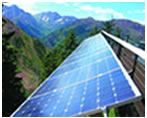Renewable Energy Technologies
Solar Electric
Solar electric or photovoltaic (PV) modules directly convert sunlight into electricity by making use of the photovoltaic effect. The photovoltaic effect occurs when light strikes certain materials called semi-conductors, causing electrons in these materials to become dislodged. These electrons create an electrical current if they are forced to flow in one direction.
The solar cells, which make up the PV module, generally use the semi-conductor, silicon, because of its unique chemical properties. Silicon containing boron impurities is electron rich or negatively charged, while silicon that contains phosphorous impurities is electron poor or positively charged. Placing negatively charged silicon at the top of the cell and positively charged silicon at the bottom creates an electric field within the PV cell. When light strikes the cell, knocking electrons free, this electric field forces the electrons to flow in a certain direction. By placing metal contacts at the top and bottom of the cell, this electric current can be drawn off and used as electricity.

On average, PV technology is 12% efficient. Since one cell or even one module does not produce enough electricity to power a home, the solar modules are strung together to form a solar array. These solar arrays can be placed on roofs or ground mounted.
Due to their versatility, PV panels have become increasingly ubiquitous, powering anything from calculators to international space station to the average residential home. Installation costs range between $2,500-$4,500 per kW, though newer technologies like tracking and high efficiency modules may have a higher cost. While the initial installation cost on a residential home can be an investment, the energy savings over time, low maintenance, and virtually zero greenhouse gas emissions make them a popular alternative to grid energy. Residents also have the option to stay on-grid so that cloudy days do not leave them powerless, and to net-meter, selling their unused energy back into the power grid.
Solar Thermal
Solar thermal or solar hot water systems are a much more efficient use of the sun’s energy than PV systems. Just like a pond on a sunny day, solar thermal systems use the sun’s energy to heat water, displacing a significant amount of hot water that would otherwise be heated by a conventional water heater using fossil fuel or electricity. The conventional water heater can still be used as a backup when the water in the storage tank falls below a certain temperature, but some residential homes also use the excess heat from a woodstove to supplement the solar hot water system. On average, installing a solar thermal system will cause a water heating bill to drop by 50-80%. Reason for solar thermal over PV?
Solar thermal systems can be divided into two categories depending on the method of fluid transportation. The system fluid is either actively pumped or passively transported by natural convection through the solar thermal collectors, piping, and storage tanks.

Active solar water heating systems:
Direct Circulation Systems
Pumps circulate water through the solar thermal collectors and into the house, where it is held for future use in the storage tank.
Indirect Circulation Systems
In colder climates, water may freeze in the pipes and solar thermal collectors outside of the home. A heat transfer fluid such as anti-freeze is substituted for water in the solar thermal collector and pumped into a heat exchanger with liquid-to-liquid heat transfer capabilities. The newly heated water is then pumped into the home and held in a storage tank.
Passive solar water heating systems:
Integral collector-storage (ICS) passive systems
ICS systems combine the storage tank with the solar thermal collector, both heating and storing the water in a solar thermal collector. Most ICS units are long dark tubes connected in a serpentine fashion and mounted in a flat insulated box. The heated water rises to the top of the collector and is piped through the house using gravity, while pressure from the water main causes cold water to flow in and refill the collector.
Thermosyphon systems
The solar thermal collector is installed below the storage tank so that hot water from the collector can flow up through the piping and into the top of the storage tank, while cold water from the bottom of the tank flows back into the bottom of the collector to be heated.
Wind
Wind systems range from small residential systems less than 1 kW in size to giant commercially owned wind farms that produce hundreds of megawatts and supply a significant portion of our energy needs. As seen by the countless commercial wind farms in the U.S., wind technology is an efficient and reliable means to generate electricity. However, wind systems must be carefully sited, taking into account wind speed and turbulence, which has a drastic affect on the energy production of the wind turbine. Since wind energy increases by roughly the cube of the wind speed, it is imperative that the wind turbines are mounted on a tall enough pole to take full advantage of the location’s wind resources and minimize the wind turbulence.

Wind turbines have a remarkably simple design. The kinetic energy in the wind rotates the rotor blades of the wind turbine, converting kinetic energy to rotational energy. As the wind turbine revolves, it turns the shaft connected to the rotor, which in turn supplies power to the generator, converting rotational energy into electricity.






